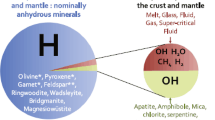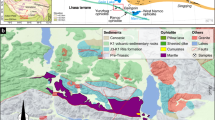Abstract
There is evidence that in Mesozoic and Palaeogene times both north and south subpolar areas had a mild climate1,2. Unlike the present day climatic symmetry, with warm equatorial regions and ice-covered polar regions, a strong planetary asymmetry developed in the middle Miocene, when the Antarctic ice cap was established while the northern high latitudes remained unglaciated3. The symmetry was restored when a Northern Hemisphere continental ice cover was established ∼3 Myr ago in the middle Pliocene4. These changes influenced the formation of deep water in the ocean. At present the cold, dense bottom waters originate in only two high latitude areas—the Weddell Sea producing Antarctic Bottom Water, and the Norwegian Sea, producing Norwegian Sea Overflow Water which after mixing is a major component of the North Atlantic Deep Water. The production of cold deep water in the Southern Ocean started at the Eocene–Oligocene boundary3. We present here new evidence from isotope analyses of benthic Foraminifera from DSDP site 116 indicating that the production of oxygenated deep water in the North Atlantic Ocean started in the late middle-Miocene, ∼12 Myr ago.
Similar content being viewed by others
References
Lamb, H. H. Climate, Present, Past and Future (Methuen, London, 1977).
Savin, S. M. A. Rev. Earth planet. Sci. 5, 319–355 (1977).
Shackleton, N. J. & Kennett, J. P. Init. Rep. DSDP 29, 801–807 (1974).
Shackleton, N. J. & Opdyke, N. D. Nature 270, 216–219 (1977).
Laughton, A. S. et al. Init. Rep. DSDP 12, 395–672 (1972).
Duplessy, J.-C. in Climatic Change (ed. Gribbin, J.) 46–67 (Cambridge University Press, 1978).
Shackleton, N. J. in Variation du Climat au Court du Pleistocene (ed. Labeyrie, J.) 203–209 (CNRS, Paris, 1974).
Shackleton, N. J. in Stable Isotopes in Oceanographic Studies and Palaeotemperatures (ed. Tongiorgi, E.) 115–159 (Consigl. Nat. d. Ricerche, Lab. di Geol. Nucl. Pisa, 1965).
Shackleton, N. J. in The Fate of Fossil Fuel CO2 in the Oceans (eds Andersen, N. R. & Malahoff, A.) 401–427 (Plenum, New York, 1977).
Duplessy, J.-C., Lalou, C. & Vinot, A.-C. Science 168, 250–251 (1970).
Douglas, R. G. & Savin, S. M. Init. Rep. DSDP 17, 591–605 (1973).
Boersma, A. & Shackleton, N. J. Init. Rep. DSDP 39, 911–924 (1977).
Vergnaud-Grazzini, C., Pierre, C. & Létolle, R. Oceanol. Acta 1, 381–390 (1978).
Savin, S. M., Douglas, R. G. & Stehli, F. G. Bull. geol. Soc. Am. 86, 1499–1510 (1975).
Kroopnik, P., Deuser, W. G. & Craig, H. J. geophys. Res. 75, 7668–7671 (1970).
Duplessy, J.-C. thesis (1972).
Craig, H. J. geophys. Res. 75, 691 (1970).
Rabussier, D. thesis, Univ. Paris (1979).
Thiede, J. Phil. Trans. R. Soc. (in the press).
Nilsen, T. H. Nature 274, 786–788 (1978).
Author information
Authors and Affiliations
Rights and permissions
About this article
Cite this article
Blanc, PL., Rabussier, D., Vergnaud-Grazzini, C. et al. North Atlantic Deep Water formed by the later middle Miocene. Nature 283, 553–555 (1980). https://doi.org/10.1038/283553a0
Received:
Accepted:
Issue Date:
DOI: https://doi.org/10.1038/283553a0
- Springer Nature Limited
This article is cited by
-
Oxygen isotope calibration of the onset of ice-rafting and history of glaciation in the North Atlantic region
Nature (1984)
-
Evidence for Oligocene–Middle Miocene abyssal circulation changes in the western North Atlantic
Nature (1983)
-
Climate and paleoclimate: What we can learn about solar luminosity variations
Solar Physics (1981)





